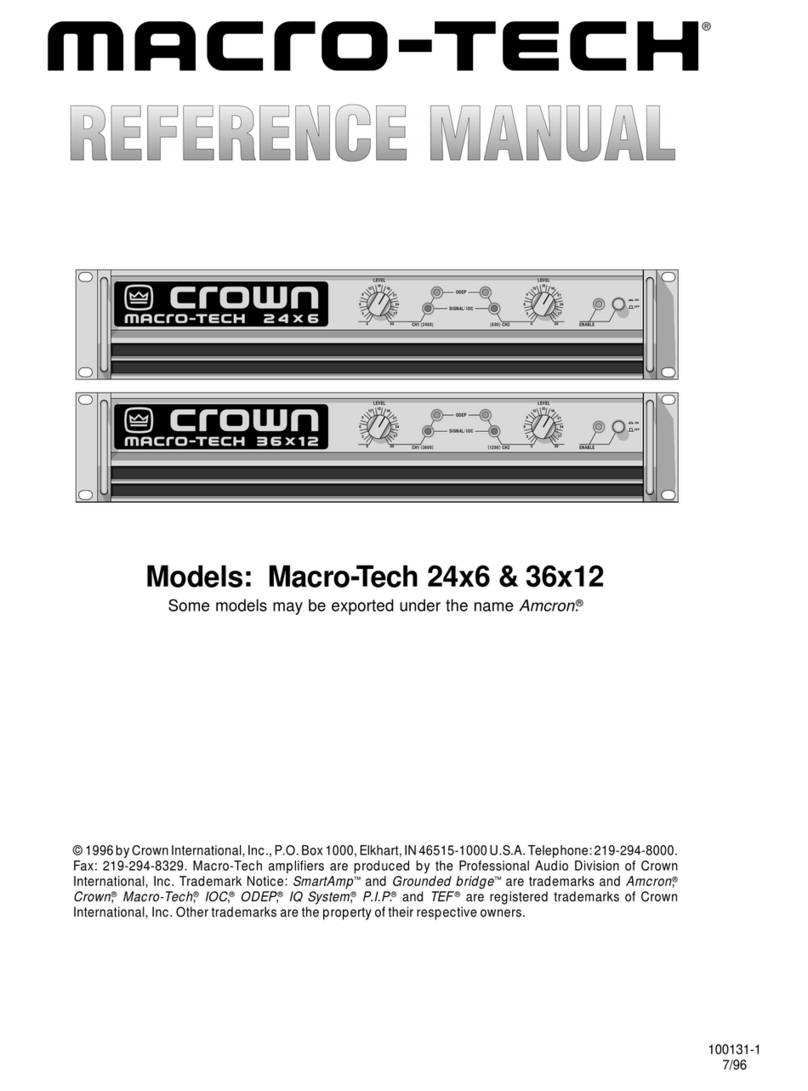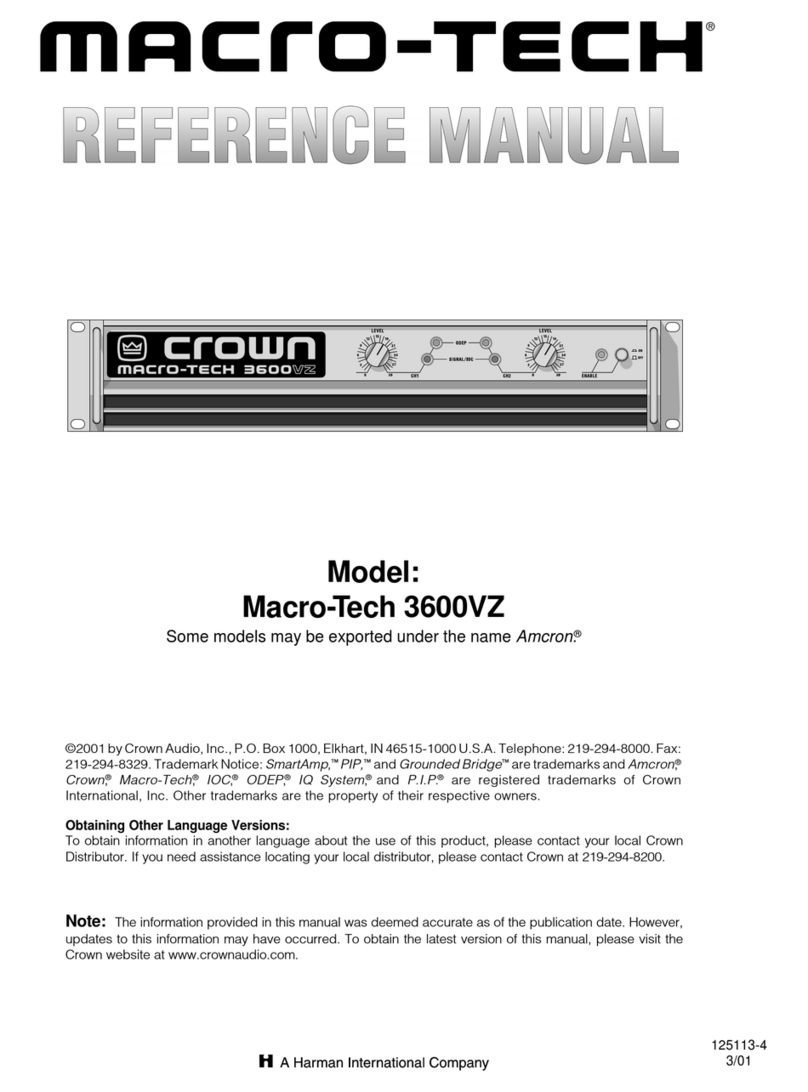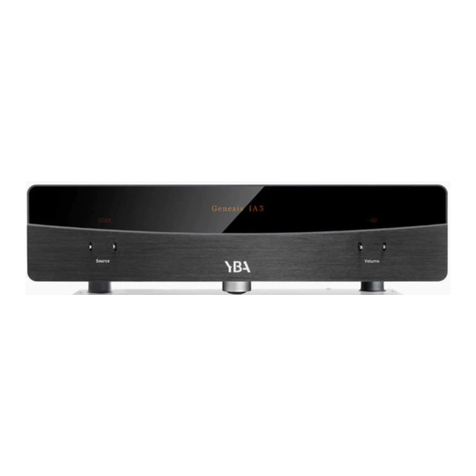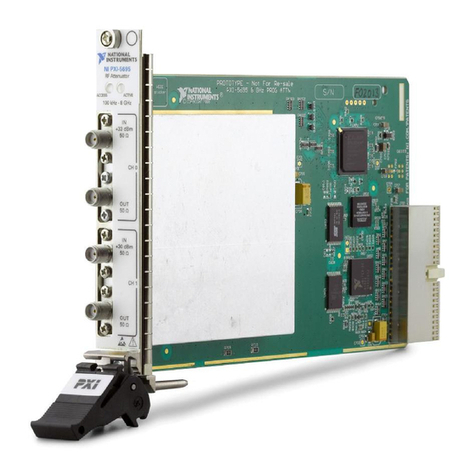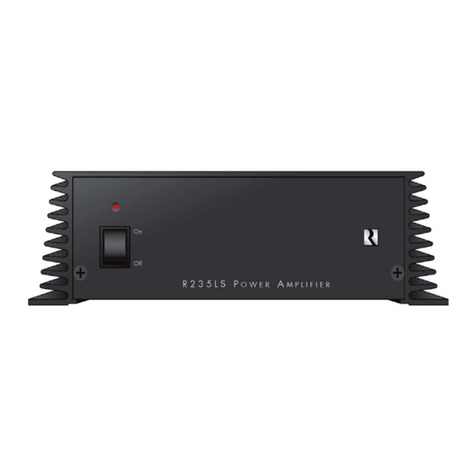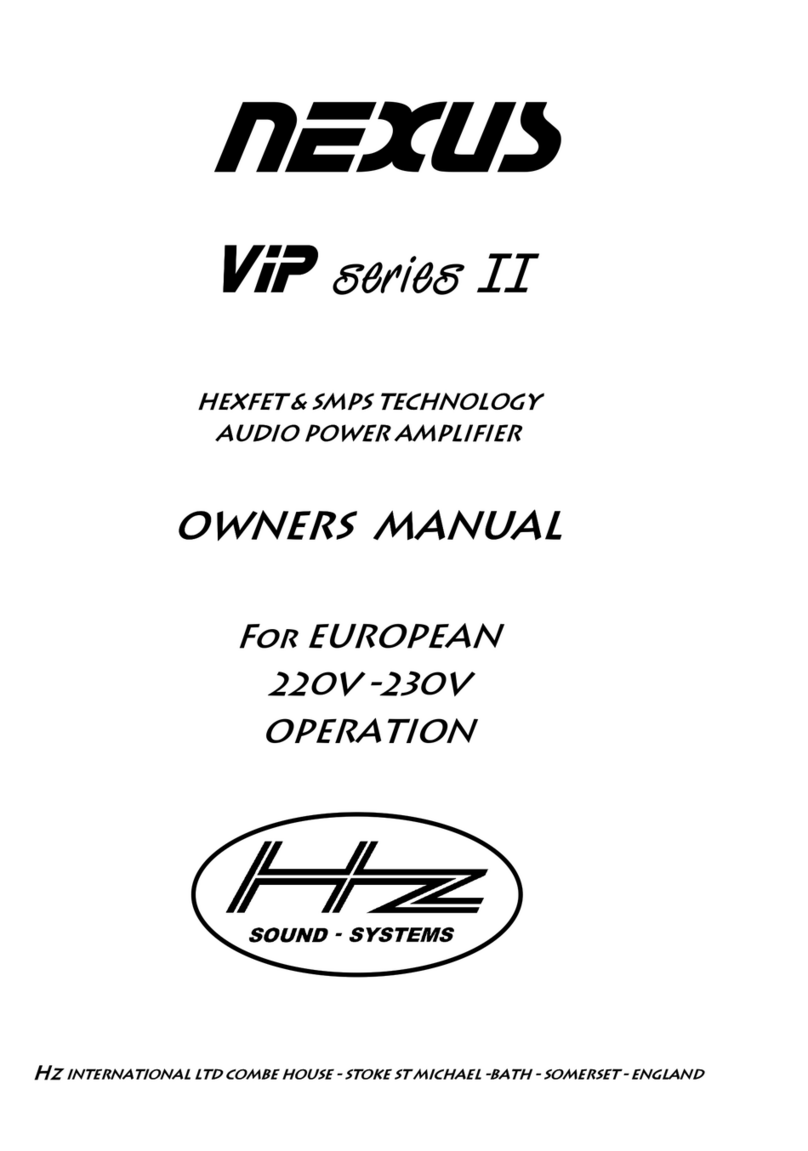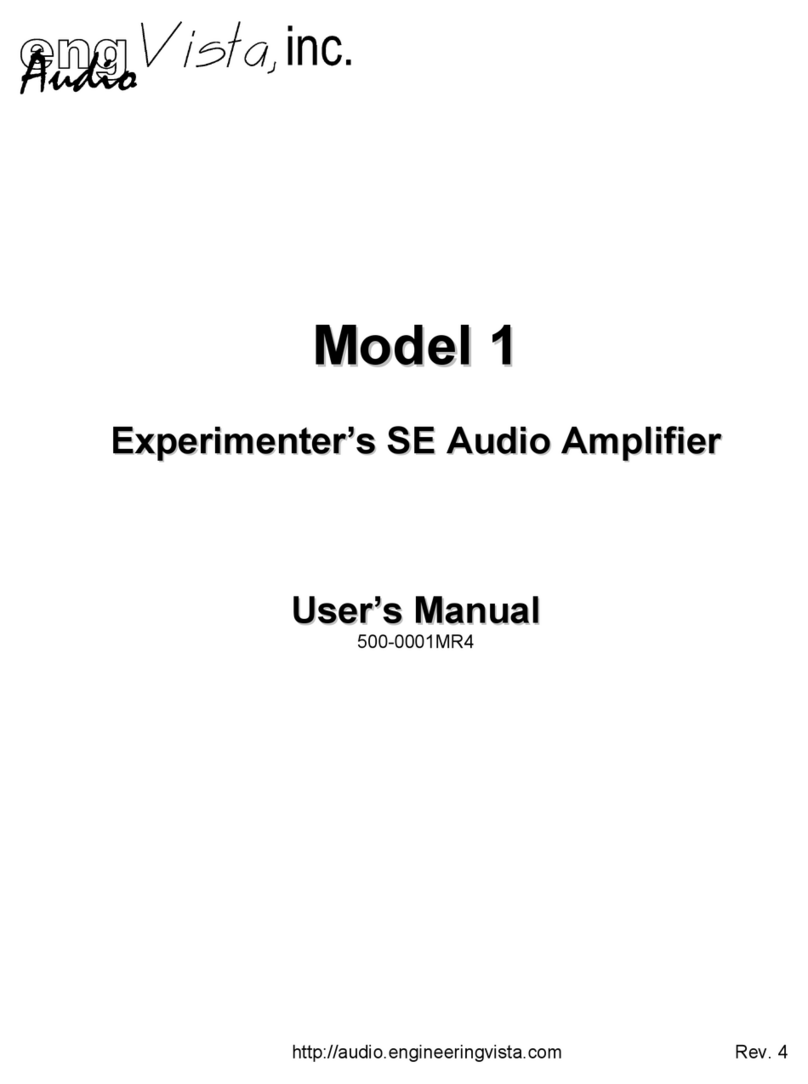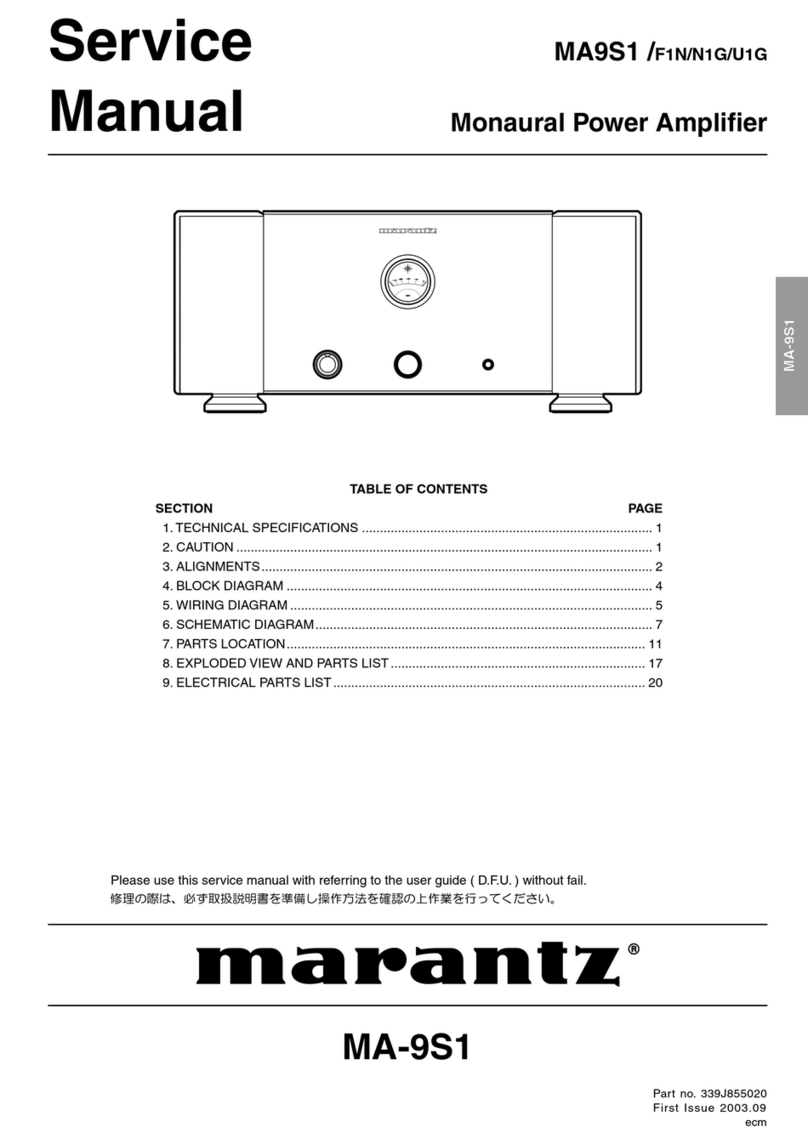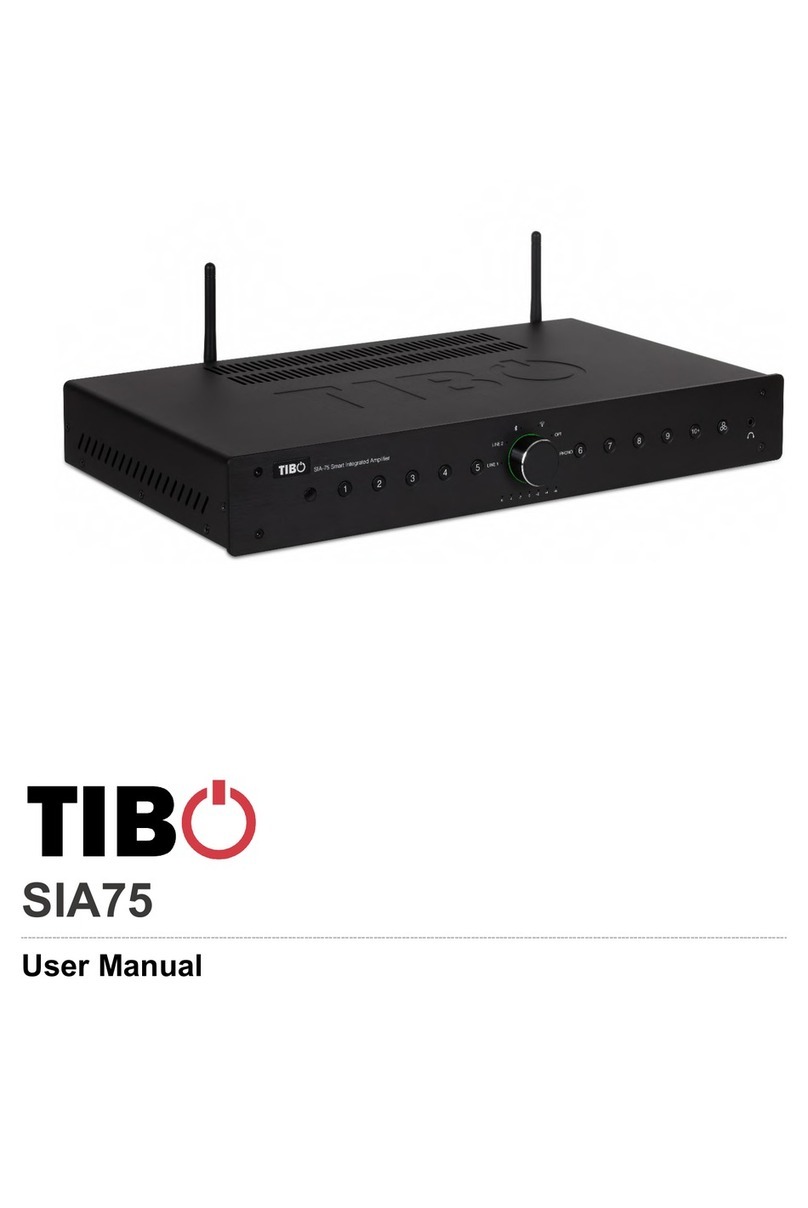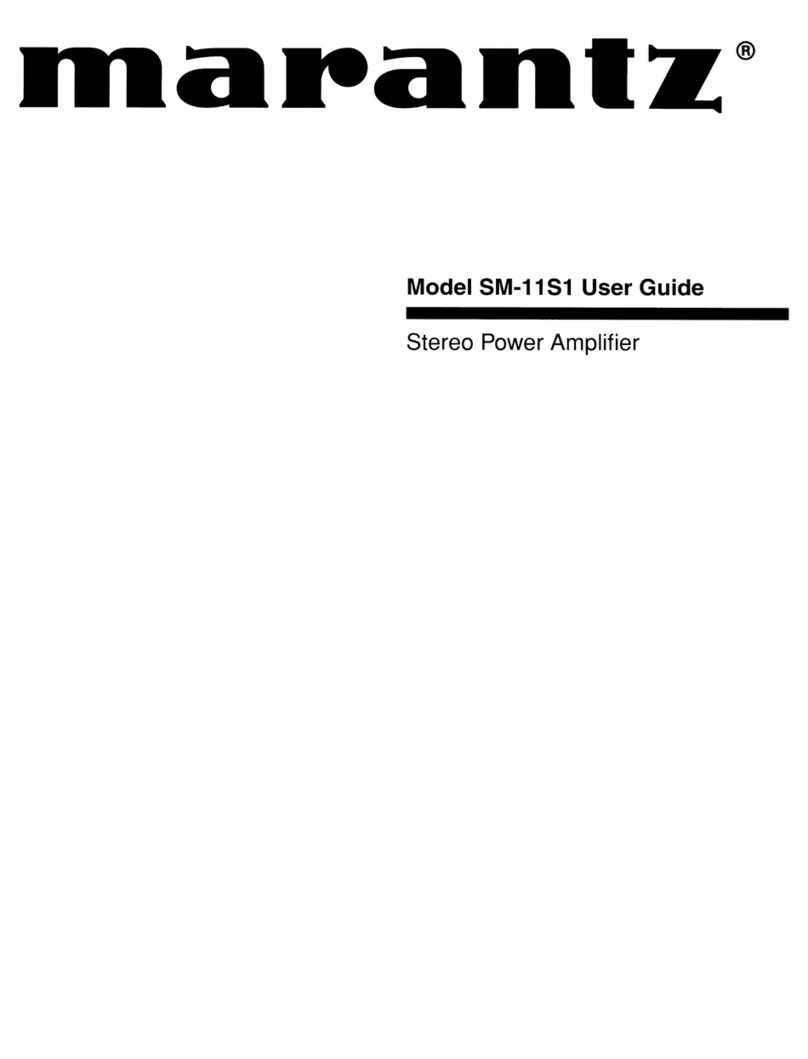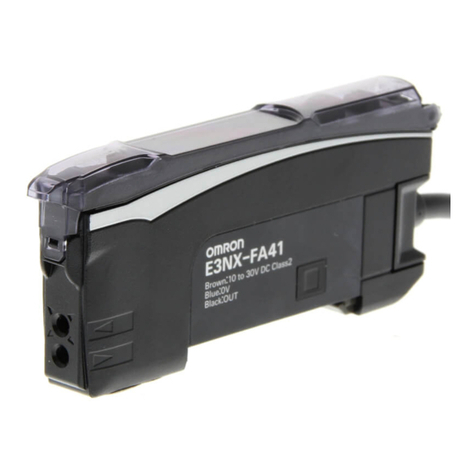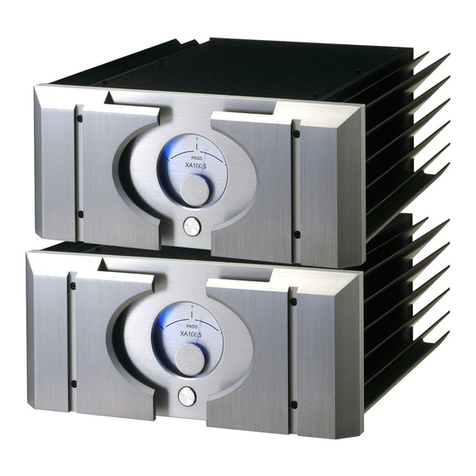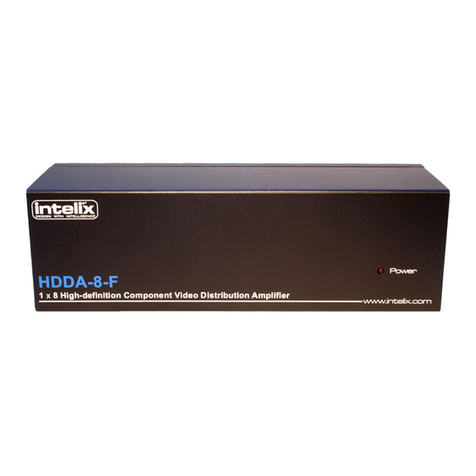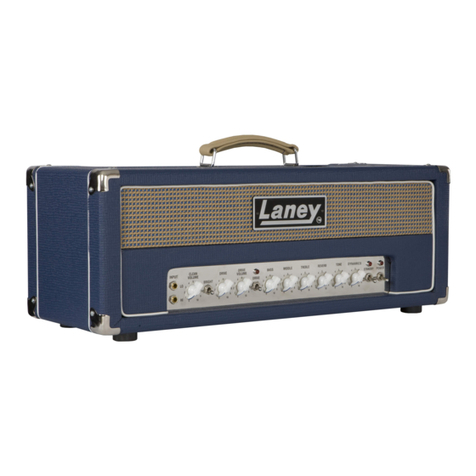Macro-Tech 24x6 User manual

Models: Macro-Tech®24x6 & 36x12
125782-3
3/00
© 2000 by Crown International, Inc., P.O. Box 1000, Elkhart, IN 46515-1000 U.S.A. Telephone: 219-294-
8000.Fax:219-294-8329.Macro-TechamplifiersareproducedbytheProfessionalAudioDivisionofCrown
International, Inc. Trademark Notice:
SmartAmp,
™
Grounded Bridge
™ and
PIP
™are trademarks and
Amcron,®
Crown
,
®
Macro-Tech
,
®
IOC
,®
ODEP
,®
IQ,®IQ System
,®
and P.I.P.
®are registered trademarks of
Crown International, Inc. Other trademarks are the property of their respective owners.
Some models may be exported under the name
Amcron
.®

WORLDWIDE
SUMMARY OF WARRANTY
The Crown Audio Division of Crown International, Inc., 1718 West
MishawakaRoad,Elkhart,Indiana46517-4095U.S.A.warrantstoyou,the
ORIGINAL PURCHASER and ANY SUBSEQUENT OWNER of each
NEW Crown product, for a period of three (3) years from the date of
purchase by the original purchaser (the “warranty period”) that the new
Crown product is free of defects in materials and workmanship, and we
furtherwarrantthenewCrownproductregardlessofthereasonforfailure,
except as excluded in this Crown Warranty.
ITEMS EXCLUDED FROM THIS CROWN WARRANTY
This Crown Warranty is in effect only for failure of a new Crown product
whichoccurred withinthe WarrantyPeriod. Itdoes notcover anyproduct
which has been damaged because of any intentional misuse, accident,
negligence,orlosswhichiscoveredunderanyofyourinsurancecontracts.
ThisCrownWarrantyalsodoesnotextendtothenewCrownproductifthe
serial number has been defaced, altered, or removed.
WHAT THE WARRANTOR WILL DO
Wewillremedy any defect,regardless of thereasonfor failure (exceptas
excluded), by repair, replacement, or refund. We may not elect refund
unless you agree, or unless we are unable to provide replacement, and
repairisnotpractical orcannotbetimelymade.Ifarefundiselected,then
youmustmakethedefectiveormalfunctioningproductavailabletousfree
andclearofallliensorotherencumbrances.Therefundwillbeequaltothe
actualpurchaseprice,notincludinginterest,insurance,closingcosts,and
otherfinancechargeslessareasonabledepreciationontheproductfrom
thedateoforiginalpurchase.Warrantyworkcanonlybeperformedatour
authorizedservicecenters.Wewillremedythedefectandshiptheproduct
from the service center within a reasonable time after receipt of the
defective product at our authorized service center.
HOW TO OBTAIN WARRANTY SERVICE
You must notify us of your need for warranty service not later than ninety
(90)days after expirationof the warrantyperiod. All componentsmust be
shipped in a factory pack. Corrective action will be taken within a
reasonable time of the date of receipt of the defective product by our
authorized service center. If the repairs made by our authorized service
center are not satisfactory, notify our authorized service center
immediately.
DISCLAIMER OF CONSEQUENTIAL AND INCIDENTAL DAMAGES
YOUARENOTENTITLEDTORECOVERFROMUSANYINCIDENTAL
DAMAGES RESULTING FROM ANY DEFECT IN THE NEW CROWN
PRODUCT.THISINCLUDESANYDAMAGETOANOTHERPRODUCT
OR PRODUCTS RESULTING FROM SUCH A DEFECT.
WARRANTY ALTERATIONS
No person has the authority to enlarge, amend, or modify this Crown
Warranty.ThisCrownWarrantyisnotextendedbythelengthoftimewhich
you are deprived of the use of the new Crown product. Repairs and
replacementpartsprovided under thetermsof this CrownWarranty shall
carry only the unexpired portion of this Crown Warranty.
DESIGN CHANGES
Wereservetherighttochangethedesignofanyproductfromtimetotime
without notice and with no obligation to make corresponding changes in
productspreviouslymanufactured.
LEGAL REMEDIES OF PURCHASER
Noaction to enforce this Crown Warranty shallbe commencedlater than
ninety (90) days after expiration of the warranty period.
THIS STATEMENT OF WARRANTY SUPERSEDES ANY OTHERS
CONTAINED IN THIS MANUAL FOR CROWN PRODUCTS.
9/90
NORTH AMERICA
SUMMARY OF WARRANTY
The Crown Audio Division of Crown International, Inc., 1718 West Mishawaka
Road, Elkhart, Indiana 46517-4095 U.S.A. warrants to you, the ORIGINAL
PURCHASERandANYSUBSEQUENTOWNERofeachNEWCrownproduct,
foraperiodofthree(3)yearsfromthedateofpurchasebytheoriginalpurchaser
(the“warrantyperiod”)thatthenewCrownproductisfreeofdefectsinmaterials
andworkmanship.WefurtherwarrantthenewCrownproductregardlessofthe
reason for failure, except as excluded in this Warranty.
ITEMS EXCLUDED FROM THIS CROWN WARRANTY
This Crown Warranty is in effect only for failure of a new Crown product which
occurred within the Warranty Period. It does not cover any product which has
beendamagedbecauseofanyintentionalmisuse,accident,negligence,orloss
which is covered under any of your insurance contracts. This Crown Warranty
also does not extend to the new Crown product if the serial number has been
defaced, altered, or removed.
WHAT THE WARRANTOR WILL DO
We will remedy any defect, regardless of the reason for failure (except as
excluded),byrepair,replacement,orrefund.Wemaynotelectrefundunlessyou
agree,orunlessweareunabletoprovidereplacement,andrepairisnotpractical
orcannotbetimelymade.Ifarefundiselected,thenyoumustmakethedefective
or malfunctioning product available to us free and clear of all liens or other
encumbrances. The refund will be equal to the actual purchase price, not
including interest, insurance, closing costs, and other finance charges less a
reasonable depreciation on the product from the date of original purchase.
Warrantyworkcanonlybeperformedatourauthorizedservicecentersoratthe
factory.We will remedythe defect andship the productfrom the servicecenter
orourfactorywithinareasonabletimeafterreceiptofthedefectiveproductatour
authorized service center or our factory. All expenses in remedying the defect,
including surface shipping costs in the United States, will be borne by us. (You
mustbeartheexpenseofshippingtheproductbetweenanyforeigncountryand
theportofentryintheUnitedStatesandalltaxes,duties,andothercustomsfees
for such foreign shipments.)
HOW TO OBTAIN WARRANTY SERVICE
You must notify us of your need for warranty service not later than ninety (90)
daysafterexpirationofthewarrantyperiod.Allcomponentsmustbeshippedin
a factory pack, which, if needed, may be obtained from us free of charge.
Correctiveaction will be taken withina reasonabletime of the date of receipt of
thedefectiveproductbyusorourauthorizedservicecenter.Iftherepairsmade
by us or our authorized service center are not satisfactory, notify us or our
authorized service center immediately.
DISCLAIMER OF CONSEQUENTIAL AND INCIDENTAL DAMAGES
YOU ARE NOT ENTITLED TO RECOVER FROM US ANY INCIDENTAL
DAMAGES RESULTING FROM ANY DEFECT IN THE NEW CROWN
PRODUCT. THIS INCLUDES ANY DAMAGE TO ANOTHER PRODUCT OR
PRODUCTS RESULTING FROM SUCH A DEFECT. SOME STATES DO
NOT ALLOW THE EXCLUSION OR LIMITATIONS OF INCIDENTAL OR
CONSEQUENTIAL DAMAGES, SO THE ABOVE LIMITATION OR
EXCLUSION MAY NOT APPLY TO YOU.
WARRANTY ALTERATIONS
Nopersonhastheauthoritytoenlarge,amend, or modify thisCrownWarranty.
This Crown Warranty is not extended by the length of time which you are
deprived of the use of the new Crown product. Repairs and replacement parts
providedunderthetermsofthisCrownWarrantyshallcarryonlytheunexpired
portion of this Crown Warranty.
DESIGN CHANGES
Wereservetherighttochangethedesignofanyproductfromtimetotimewithout
notice and with no obligation to make corresponding changes in products
previouslymanufactured.
LEGAL REMEDIES OF PURCHASER
THIS CROWN WARRANTY GIVES YOU SPECIFIC LEGAL RIGHTS, YOU
MAYALSOHAVEOTHERRIGHTSWHICHVARYFROMSTATETOSTATE.
NoactiontoenforcethisCrownWarrantyshallbecommencedlaterthanninety
(90) days after expiration of the warranty period.
THIS STATEMENT OF WARRANTY SUPERSEDES ANY OTHERS
CONTAINED IN THIS MANUAL FOR CROWN PRODUCTS.
9/90
Telephone: 219-294-8200. Facsimile: 219-294-8301
Telephone: 219-294-8200. Facsimile: 219-294-8301
THREE YEAR
FULL WARRANTY
YEAR
3
YEAR
3

The information furnished in this manual does not include all of the details of design, production, or variations
of the equipment. Nor does it cover every possible situation which may arise during installation, operation or
maintenance. If you need special assistance beyond the scope of this manual, please contact our Technical
Support Group.
Crown Audio Division Technical Support Group
Plant 2 SW, 1718 W. Mishawaka Rd., Elkhart, Indiana 46517 U.S.A.
Phone: 800-342-6939 (North America, Puerto Rico and Virgin Islands) or 219-294-8200
Fax: 219-294-8301 Fax Back (North America only): 800-294-4094 or 219-293-9200
Fax Back (International): 219-294-8100 Internet: http://www.crownaudio.com
Printed on
recycled paper.
The lightning bolt
triangle is used to
alert the user to the
risk of electric shock.
The exclamation point
triangle is used to alert the
user to important operating
or maintenance instructions.
WARNING
TO REDUCE THE RISK OF ELECTRIC
SHOCK, DO NOT EXPOSE THIS
EQUIPMENT TO RAIN OR MOISTURE!
Magnetic Field
CAUTION! Do not locate sensitive high-gain
equipment such as preamplifiers or tape decks
directly above or below the unit. Because this
amplifier has a high power density, it has a strong
magneticfieldwhichcaninducehumintounshielded
devices that are located nearby. The field is stron-
gest just above and below the unit.
If an equipment rack is used, we recommend locat-
ing the amplifier(s) in the bottom of the rack and the
preamplifier or other sensitive equipment at the top.
C A U T I O N
RISK OF ELECTRIC SHOCK
DO NOT OPEN
TO PREVENT ELECTRIC SHOCK DO
NOT REMOVE TOP OR BOTTOM
COVERS. NO USER SERVICEABLE
PARTS INSIDE. REFER SERVICING TO
QUALIFIED SERVICE PERSONNEL.
DISCONNECT POWER CORD BE-
FORE REMOVING REAR INPUT
MODULE TOACCESS GAIN SWITCH.
A V I S
RISQUE DE CHOC ÉLECTRIQUE
N’OUVREZ PAS
ÀPRÉVENIR LE CHOC ÉLECTRIQUE
N’ENLEVEZ PAS LES COUVERCLES. IL
N’Y A PAS DES PARTIES
SERVICEABLE ÀL’INTÉRIEUR. TOUS
REPARATIONS DOIT ETRE FAIRE PAR
PERSONNEL QUALIFIÉSEULMENT.
DÉBRANCHER LA BORNE AVANT
D’OUVRIR LA MODULE EN ARRIÈRE.

Page 4 Reference Manual
Macro-Tech
®
24x6 & 36x12 Power Amplifiers
Important Safety Instructions
1) Read these instructions.
2) Keep these instructions
.
3) Heed all warnings.
4) Follow all instructions.
5) Do not use this apparatus near water.
6) Clean only with a dry cloth.
7) Do not block any ventilation openings. Install in accordance with the
manufacturer’s instructions.
8) Do not install near any heat sources such as radiators, heat registers, stoves,
or other apparatus that produce heat.
9) Do not defeat the safety purpose of the polarized or grounding-type plug. A
polarized plug has two blades with one wider than the other. A grounding-
type plug has two blades and a third grounding prong. The wide blade or the
third prong is provided for your safety. If the provided plug does not fit into
your outlet, consult an electrician for replacement of the obsolete outlet.
10) Protectthepower cord from beingwalkedon orpinched, particularlyat plugs,
convenience receptacles, and the point where they exit from the apparatus.
11) Only use attachments/accessories specified by the manufacturer.
12) Use only with a cart, stand, bracket, or table specified by the manufacturer, or
sold with the apparatus. When a cart is used, use caution when moving the
cart/apparatus combination to avoid injury from tip-over.
13) Unplug this apparatus during lightning storms or when unused for long peri-
ods of time.
14) Refer all servicing to qualified service personnel. Servicing is required when
the apparatus has been damaged in any way, such as power-supply cord or
plug is damaged, liquid has been spilled or objects have fallen into the appa-
ratus, the apparatus has been exposed to rain or moisture, does not operate
normally, or has been dropped.

Page 5Reference Manual
Macro-Tech
®
24x6 & 36x12 Power Amplifiers
CONTENTS
1 Welcome ............................................................................ 7
1.1 Unpacking ................................................................... 7
1.2 Features....................................................................... 7
2 Facilities ............................................................................ 8
3 Installation ....................................................................... 10
3.1 Mounting ................................................................... 10
3.2 Cooling ...................................................................... 10
3.3 Wiring ........................................................................ 11
3.3.1 Input Connection ............................................. 12
3.3.2 Output Connection .......................................... 14
3.3.3 Additional Load Protection............................... 16
3.4 AC Power Requirements ............................................ 16
4 Operation......................................................................... 17
4.1 Precautions................................................................ 17
4.2 Indicators................................................................... 17
4.3 Protection Systems .................................................... 18
4.3.1 ODEP .............................................................. 18
4.3.2 Standby Mode................................................. 19
4.3.3 Transformer Thermal Protection ....................... 19
4.3.4 Circuit Breakers............................................... 19
4.4 Controls ..................................................................... 19
4.5 Filter Cleaning............................................................ 20
5 Technical Information...................................................... 21
5.1 Overview ................................................................... 21
5.2 VZ Power
(Macro-Tech 36x12 only) ............................
21
5.2.1 Background .................................................... 21
5.2.2 The VZ Supply................................................. 22
5.3 Circuit Theory ............................................................ 22
6 Specifications.................................................................. 25
7 AC Power Draw & Heat Dissipation ................................ 29
8 Accessories ..................................................................... 30
8.1 PIP Modules .............................................................. 30
8.2 Level Control Security Kit ........................................... 32
9 Service ............................................................................. 33
9.1 Worldwide Service ..................................................... 33
9.2 North American Service ............................................. 33
9.2.1 Service at a North American Service Center .... 33
9.2.2 Factory Service ............................................... 33

Page 6 Reference Manual
Macro-Tech
®
24x6 & 36x12 Power Amplifiers
ILLUSTRATIONS
1.1 Macro-Tech 36x12 Amplifier ......................................................7
2.1 Front Facilities ...........................................................................8
2.2 Rear Facilities ...........................................................................9
3.1 Mounting Dimensions..............................................................10
3.2 Top View of a Rack-Mounted Unit ............................................10
3.3 Proper Air Flow in a Rack Cabinet ...........................................10
3.4 Wiring (a Macro-Tech 36x12 is shown) ....................................11
3.5 Unbalanced Input Wiring.........................................................12
3.6 Balanced Input Wiring.............................................................12
3.7 Balanced and Unbalanced Phone Plug Wiring ........................12
3.8 Subsonic Filter Capacitors ......................................................13
3.9 Unbalanced RFI Filters............................................................13
3.10 Balanced RFI Filters ................................................................13
3.11 Wire Size Nomograph .............................................................14
3.12 Inductive Load (Transformer) Network .....................................16
3.13 Loudspeaker Fuse Selector Nomograph .................................16
4.1 Indicators................................................................................17
4.2 ODEP and Signal/IOC Indicator States ....................................18
4.3 Input Sensitivity and Ground Lift Switches ...............................20
5.1 A Typical Power Supply...........................................................21
5.2 Complex Musical Waveforms ..................................................22
5.3 VZ Supply in Parallel Mode .....................................................22
5.4 VZ Supply in Series Mode .......................................................22
5.5 Circuit Block Diagram .............................................................24
6.1 Typical Frequency Response ..................................................27
6.2 Typical Damping Factor ..........................................................27
6.3 Typical Output Impedance ......................................................27
6.4 Typical Phase Response .........................................................28
7.1 Macro-Tech 24x6 Pwr Draw, Current Draw and Therm Dis .......28
7.1 Macro-Tech 36x12 Pwr Draw, Current Draw and Therm Dis .....29
8.1 Installing a PIP Module............................................................30
8.2 Installing a Level Control Shaft Lock ........................................32

Page 7Reference Manual
Macro-Tech
®
24x6 & 36x12 Power Amplifiers
Fig. 1.1 Macro-Tech 36x12 Amplifier
1 Welcome
Congratulations on your purchase of a
Macro-Tech
®
dual level professional power amplifier. Your amplifier
has a separate high-power and medium-power chan-
nel,making itideal forbiamplified systems.The Macro-
Tech24x6combinesonechannelofaMacro-Tech2400
withonechannelofaMacro-Tech600.TheMacro-Tech
36x12 combines one channel of a Macro-Tech 3600VZ
with one channel of a Macro-Tech 1200. And because
each model has a separate power supply for each
channel, each channel can be treated as a separate
power amplifier.
As a member of the Macro-Tech family, your amplifier
offers the added benefit of
ODEP
®
protection which
keepstheshowgoinglongafterotherampswouldther-
maloffandProgrammableInputProcessor(PIP™)com-
patibility to accept custom input modules (see Section
8 for available input modules).
This manual will help you successfully install and use
your new amplifier. We strongly recommend you read
allinstructions,warningsandcautionscontainedwithin.
Also for your protection, please send in your warranty
registration card today and save your bill of sale be-
cause it is your official proof of purchase.
1.1 Unpacking
Please unpack and inspect your new amplifier for any
damage that may have occurred during transit. If dam-
age is found, notify the transportation company imme-
diately.Only you, theconsignee, mayinitiate a claimfor
shipping damage. Crown will be happy to cooperate
fully as needed. Save the shipping carton as evidence
of damage for the shipper’s inspection.
Even if the unit arrived in perfect condition, as most do,
save all packing materials so you will have them if you
ever need to transport the unit. NEVER SHIP THE UNIT
WITHOUT THE FACTORY PACK.
1.2 Features
Here are some of the impressive features:
❏Crown’s
Grounded Bridge
™design delivers incredible
voltage swings without using stressful output transistor
configurations like conventional amplifiers. The results
are lower distortion and superior reliability.
❏Patented ODEP (Output Device Emulation Protection)
circuitry compensates for overheating and overload to
keep the amplifier working long after others would fail.
❏
IOC
®(Input/Output Comparator) circuitry immediately
alerts of any distortion exceeding 0.05%, providing
dynamic
proof of distortion-free performance
.
❏PIP connector accepts accessories that tailor the
amplifier to suit specific applications.
❏Very low harmonic and intermodulation distortion give
the best
dynamic transfer function
in the industry.
❏High damping factor provides superior control over
low frequency drivers for a clean, accurate low end.
❏Full protection against shorted outputs, open circuits,
DC, mismatched loads, general overheating, high
frequency overloads and internal faults.
❏Extra rugged, extruded aluminum front panel with
ODEP and Signal Presence/IOC indicators for each
channel, as well as an Enable indicator.
❏Macro-Tech 36x12:
Articulated VZ power supply for
Channel 1 (3600) provides the best power matching to
your load.
❏Efficient heat sinks and forced air cooling prevent
overheating and prolong component life.
❏Balanced inputs with three-position sensitivity switch
and adjustable front panel level controls.
❏5-way binding post outputs provide versatile
connection.
❏Mounts in a standard 19-inch (48.3-cm) equipment
rack (units can also be stacked).
❏Three Year “No-Fault” Full Warranty completely
protects your investment and guarantees its
specifications.

Page 8 Reference Manual
Macro-Tech
®
24x6 & 36x12 Power Amplifiers
Fig. 2.1 Front Facilities
2 Facilities
A. Dust Filter
Thedustfilters removelarge particlesfromtheairatthe
airintake.Checkthefiltersregularlytobesuretheydon’t
become clogged. The filter elements can be easily re-
moved for cleaning by gently pulling them away from
the front panel. See Section 3.2 and 4.5.
B. Level Controls
The level for each channel is set with these convenient
controls mounted on the front panel. Each level control
has31detentsforpreciseadjustment(seeSection 4.4).
A security option is available to prevent tampering (see
Section 8.2).
C. Signal / IOC Indicators
These green multifunction indicators show signal pres-
ence and distortion for each channel. As signal pres-
ence indicators, they flash synchronously with the
output audio signals to show their presence. As IOC
(Input/Output Comparator) indicators, they flash
brightly with a 0.1 second hold delay if there is a differ-
ence of 0.05% or more between the input and output
signal waveforms. This provides
proof of distortion-free
performance
. Another IOC function is to indicate input
overload. If an input signal is too large, the indicator for
the affected channel flashes brightly with a 0.5 second
hold delay to show clipping distortion.
D. ODEP Indicators
During normal operation of the ODEP (Output Device
Emulation Protection) circuitry, these amber indicators
glow brightly to show the presence of reserve thermal-
dynamic energy. They dim proportionally as energy re-
servesdecrease.In the rareeventthat energy reserves
are depleted, the indicators turn off and ODEP propor-
tionally limits output drive so the amplifier can safely
continue operating even under severe conditions.
These indicators can also help identify more unusual
operating conditions (see Section 4.2).
E. Enable Indicator
This indicator lights when the amplifier has been “en-
abled” or turned on and AC power is present (see Sec-
tion 4.2).
F. Enable Switch
Thispush button isused to turn the amplifieron and off.
When turned on, the output is muted for approximately
four seconds to protect your system from start-up tran-
sients. (This delay can be changed. Contact Crown’s
Technical Support Group for details.)
G. Power Cord
An appropriate power cord is provided. 120 VAC, 60
Hz units have a 20-amp (12 AWG) line cord with a
grounded NEMA 5-15P plug. See Section 7 for AC
power usage.

Page 9Reference Manual
Macro-Tech
®
24x6 & 36x12 Power Amplifiers
Fig. 2.2 Rear Facilities
H. Reset Switches
The reset switches are used to reset the breakers that
safeguard each power supply from overload.
I. PIP Module
The standard P.I.P.-FX is included with your amplifier. It
providesfemaleXLRinputconnectors.Avarietyofother
PIP modules can be used in place of the P.I.P.-FX. They
add additional features that customize the amplifier for
different applications (see Section 8.1 for information
on available PIP modules).
❑Input Sensitivity Switch
Thethree-positioninputsensitivity switchlocatedinside
the amplifier is accessed by removing the PIP module
(I). It is factory-set to 0.775 volts for rated 8 ohm output.
It can also be set to 1.4 volts for rated output, or a volt-
age gain of 26 dB (see Section 4.4).
J. Balanced Phone Jack Inputs
Balanced ¼-inch phone jack input connectors are pro-
vided on the back panel of your amplifier. The phone
jacks can be wired for either balanced (tip, ring and
sleeve) or unbalanced (tip and sleeve) input signals.
Because they are electrically in parallel with the PIP in-
put connectors, input signals should not be connected
to the phone jacks when certain PIP modules are in-
stalled (see Section 3.3.1). The phone jacks can also
beusedas“daisychain” outputstosimplifyconnecting
input signals to multiple amplifiers.
K. Ground Lift Switch
This switch isolates or “lifts” the phone jack signal
grounds from the AC power ground. Activating the
switch inserts an impedance between the sleeve of
each phone jack and the unit’s AC ground to help pre-
vent the hum that can result from a ground loop.
L. Balanced XLR Inputs
The factory-installed P.I.P.-FX provides a three-pin fe-
male XLR connector for balanced input to each chan-
nel. The XLR inputs are connected in parallel with the
amplifier’s phone jack inputs. Because the P.I.P.-FX
does not have any active circuitry, its XLR connectors
can also be used as “daisy chain” outputs to connect
signals from phone jack inputs to multiple amplifiers
(see Section 3.3.1).
M. Output Jacks
A pair of versatile 5-way binding posts is provided for
the output of each channel. The 5-way binding posts
accept banana plugs, spade lugs or bare wire.
Note:
Because of its higher output power, the Macro-Tech
36x12 has an additional set of binding posts.

Page 10 Reference Manual
Macro-Tech
®
24x6 & 36x12 Power Amplifiers
3 Installation
3.1 Mounting
Macro-Tech amplifiers are designed for standard 19
inch (48.3 cm) rack mounting as well as “stack” mount-
ing without a cabinet. In a rack cabinet, it is best to
mount them directly on top of each other. This provides
efficient air flow and the best support.
Important: Due to the weight of the unit, it should be
securely fastened at the back of the cabinet.
19 in
48.3 cm
16 in
40.6 cm
3.5 in
8.9 cm
2.5 in
6.35 cm
SIDE VIEW
Fig. 3.1 Mounting Dimensions
Fig. 3.2 Top View of a Rack-Mounted Unit
AIR
FLOW
AIR FLOW
AMPLIFIER
(TOP VIEW)
RACK
CABINET
16 in
40.6 cm
2 in
(5cm)
MIN.
IMPORTANT: Be sure the back of
the amplifier is supported.
17 in
43.2 cm
AIR
FLOW
3.2 Cooling
NEVER block the amplifier’s side vents or front air in-
take. Allow at least 45 cubic feet (1.3 cubic meters) of
air flow per minute. All empty spaces in the rack cabi-
net should be covered with blank panels to prevent im-
proper air flow. The amplifier’s air flow should be
augmented with a rack cooling system if its load is less
than4 ohms andthe amplifier mustoperate at high out-
put levels. See Section 7 for additional information on
thermal dissipation.
If the air supply is unusually dusty, it may be necessary
to pre-filter it using commercial furnace filters, etc., to
prevent rapid loading of the unit’s own air filter. When
needed, the unit’s filter can be cleaned with mild dish
detergent and water (see Section 4.5).
When mounting the amplifier in a rack cabinet, the side
wallsoftherackshouldbeatleast2inches (5cm)away
from the chassis as shown in Figure 3.2.
Tip:
An easy way to verify adequate cooling is to ob-
serve the ODEP indicators while the amplifier is operat-
ing under worst-case conditions. If the indicators dim,
additional cooling is recommended.
If your rack cabinet has a front door that could block air
flow to the amplifier’s air intakes, you must provide ad-
equate air flow with either a grill in the door or by pres-
surizing the air behind the door. Wire grilles are
recommended over perforated panels because they
tend to create less turbulence.
A good choice for pressurizing the air behind a rack
cabinetdooris tomount a“squirrelcage”blower inside
the rack (option 1 below). At the bottom of the rack,
mount the blower so it blows outside air into the space
between the door and the front of the amplifiers, pres-
surizing the “chimney” behind the door. This blower
should not blow air into or take air out of the space be-
hind the amplifiers. For racks without a door, you can
evacuate the rack by mounting the blower at the top of
the rack, so that air inside the cabinet blows out the
back (option 2 below).
BLOWER
(OPTION 2)
BLOWER
(OPTION 1)
AIR
FLOW
FRONT
OF
RACK
DOOR
AIR
FLOW
EQUIPMENT
RACK
(SIDE VIEW)
Fig. 3.3 Proper Air Flow in a Rack Cabinet

Page 11Reference Manual
Macro-Tech
®
24x6 & 36x12 Power Amplifiers
3.3 Wiring
This section describes the most common way to install
the Macro-Tech 24x6 and 36x12. Each model is de-
signed for biamplified systems and includes both a
high-power and a medium-power channel. The input
and output terminals are located on the back panel.
Please use care when making connections, selecting
signalsourcesandcontrollingtheoutputlevel.Theload
you save may be your own! Crown assumes no liability
fordamagedloadsresultingfromcarelessamplifieruse
and/or deliberate overpowering.
CAUTION: It is always wise to remove power from
the unit and turn the input level controls off while
making or changing connections—especially if the
load is a loudspeaker system. This will eliminate any
chance of loud blasts or damage to the loudspeakers.
Because each channel produces a different power
level,the Macro-Tech24x6 and 36x12 arededicatedto
Fig. 3.4 Wiring (a Macro-Tech 36x12 is shown)
two-channeloperation.TheydoNOT offermonoopera-
tion.
WARNING:Never strapthe outputs together for Par-
allel-Mono operation! Never bridge the outputs for
Bridge-Mono operation!
Installation of the Macro-Tech 24x6 and 36x12 is very
intuitive. The Channel 1 input feeds the Channel 1 out-
put and the Channel 2 input feeds the Channel 2 out-
put. Be sure to connect the output wiring as shown in
Figure 3.4. Five-way binding posts are provided to fa-
cilitate easy connection of loudspeakers to each chan-
nel.
Note: Because of its higher output power, Channel
1 of a Macro-Tech 36x12 has an additional set of bind-
ingposts.
Observecorrectloudspeakerpolarity andbe
very careful not to short the outputs of one channel to
the outputs of the other channel.

Page 12 Reference Manual
Macro-Tech
®
24x6 & 36x12 Power Amplifiers
3.3.1 Input Connection
Both the balanced XLR and phone jack inputs have a
nominal impedance of 20 k ohms (10 k ohms with un-
balancedwiring) and will accept the line-level output of
most devices. Female XLR input connectors are pro-
vided on the standard P.I.P.-FX input module (other PIP
modules are described in Section 8.1). Correct input
wiring will depend on two factors: (1) whether the input
signals are balanced or unbalanced, and (2) whether
the signal source floats or has a ground reference. Fig-
ures 3.7 and 3.8 show the recommended connection
techniques for each type of signal source.
The amplifier’s built-in ¼ inch input phone connectors
canbewiredsimilarlyforbalancedorunbalanced,float-
ingorground-referencedsources.Theconnectorshave
Fig. 3.5 Unbalanced Input Wiring Fig. 3.7 Balanced and Unbalanced Phone Plug Wiring
astandardtip-ring-sleeve(TRS)configuration: thetip is
positive (+), the ring is negative (–) and the sleeve is
ground (see Figure 3.7). Wiring for various sources fol-
lows the XLR wiring guidelines shown in Figures 3.5
and 3.6.
The phone jacks should not be used as inputs when a
PIP module with active circuitry is installed. The phone
jacks are in parallel with the output of the PIP module,
so an input signal connected to the phone jacks can
feed backwards into the active circuitry of the PIP and
cause undesirable distortion. You can use the phone
jacks for signal input with any of the following PIP mod-
ules installed: P.I.P.-FX, P.I.P.-BB, P.I.P.-FMX, P.I.P.-FXQ
and P.I.P.-FPX. All other PIP modules have active cir-
cuitry and should not be installed if you plan to connect
input signals to the phone jacks. The phone jacks can
always be used as “daisy chain” outputs to feed post-
processed signals from the PIP to the inputs of other
amplifiers.
Fig. 3.6 Balanced Input Wiring

Page 13Reference Manual
Macro-Tech
®
24x6 & 36x12 Power Amplifiers
SOLVING INPUT PROBLEMS
Sometimes large subsonic (subaudible) frequencies
arepresentin theinputsignal.Thesecandamageloud-
speakers by overloading or overheating them. To at-
tenuate such frequencies, place a capacitor in series
withthe input signal line.The graph in Figure3.8shows
some capacitor values and how they affect the fre-
quency response. Use only low-leakage paper, mylar
or tantalum capacitors.
For balanced input wiring use one of the examples in
Figure3.10. Filters A,Band C correspondto the unbal-
anced filters above. Filter D also incorporates the sub-
sonic filter described in Figure 3.8.
InputWiringTips
1. Use only shielded cable. The higher the den-
sity of the shield (the outer conductor), the better
the cable. Spiral wrapped shield is not recom-
mended.
2. When using unbalanced lines, keep the
cables as short as possible. Avoid cable lengths
greater than 10 feet (3 meters).
3. Do not run signal cables together with high-
level wiring such as loudspeaker wires or AC
cords. (This lessens the chance of hum or noise
being induced into the input cables.)
4. The amplifier should be off for at least 10
seconds before changing any connections. Re-
member, the amplifier can produce lethal output
energy and can drive loudspeakers to levels
which can cause permanent hearing damage.
Crown is not liable for personal injury or damage
incurred when a transducer or component is over-
driven.
Fig. 3.10 Balanced RFI Filters
Tip:
The P.I.P.-FX that came with your amplifier has
plenty of room on its circuit board for input filters.
Athirdproblemto avoidis hum. Thetwo mostcommon
sources of hum in an audio system are inductive cou-
pling and ground loops.
Inductive coupling can occur when input cables are
subjected to a magnetic field from a power cord or
power transformer. One way to prevent inductive cou-
pling is to lace the input cables together along their
length and route them as far away as possible from
power transformers and power cords. The use of
Another problem to avoid is the presence of large lev-
els of radio frequencies or RF in the input signal. Al-
though high RF levels may not pose a threat to the
amplifier, they can burn out tweeters or other loads that
aresensitiveto highfrequencies.ExtremelyhighRFlev-
els can also cause your amplifier to prematurely acti-
vate its protection circuitry, resulting in inefficient
operation.RF can beintroducedinto the signalby local
radio stations and from the bias signal of many tape
recorders. To prevent this from happening, place an
appropriate low-pass filter on the input(s). Some ex-
amples of unbalanced wiring are shown below:
Fig. 3.9 Unbalanced RFI Filters
Fig. 3.8 Subsonic Filter Capacitors

Page 14 Reference Manual
Macro-Tech
®
24x6 & 36x12 Power Amplifiers
shielded pair cable is another effective way to reduce
or eliminate hum resulting from inductive coupling.
Ground loops often result when two or more devices
are improperly grounded. This causes undesirable
stray currents that may produce hum in the output. The
bestway to avoid groundloops is to ensurethat all sys-
tem devices are plugged into the same power strip. In
addition, make sure that all cable shields are grounded
at one end only.
Input and output grounds are sometimes tied together
fortesting or metering.This can causefeedback oscil-
lation from load current in the test loop. In some sys-
tems, even the AC power line may provide this
feedback path. Proper grounding, input isolation and
isolation of common AC devices in the system is good
practice.
3.3.2 Output Connection
Consider the power-handling capacity of your load be-
fore connecting it to the amplifier. Crown is not liable for
damage incurred at any time due to a load being over-
powered. The use of loudspeaker protection fuses is
highly recommended (see Section 3.3.3). Also, please
paycloseattentiontotheOperatingPrecautionsinSec-
tion 4.1.
HOW TO DETERMINE
APPROPRIATE WIRE GAUGE
It is important to use loudspeaker cables with sufficient
gauge (thickness) for the length being used. The resis-
tance introduced by inadequate loudspeaker cables
will reduce both the output power and the motion con-
trol of the loudspeakers. The latter problem occurs be-
cause the damping factor decreases as the cable
Use Good Connectors
1. To prevent possible short circuits, do not
expose the loudspeaker cable connectors.
2. Do not use connectors that might
accidentally tie two channels together when
making or breaking connections (for example, a
standard three-wire stereo phone plug).
3. Connectors that can be plugged into AC
power receptacles should never be used.
4. Connectors having low current-carrying
capacity should not be used.
5. Connectors with any tendency to short
should never be used.
resistance increases. This is very important because
the amplifier’s excellent damping factor can easily be
negated by insufficient loudspeaker cables.
Use the nomograph in Figure 3.11 and the procedure
thatfollowstofind therecommendedwiregauge(AWG
or American Wire Gauge) for your system.
Fig. 3.11 Wire Size Nomograph
40
30
20
15
10
9
8
7
6
5
4
3
2
1
2
5
10
20
50
100
.04
.06
.1
.2
.4
.6
1
2
4
6
10
20
40
8000
Ohms/1000 Feet
(305 Meters) AWG (American
Wire Gauge)
Feet Meters
5000
1000
500
100
50
10
5
1
.5
.1
.05
.01
#28
#26
#24
#22
#20
#18
#16
#14
#12
#10
#8
#6
#4
#2
#0
#00
#0000
RL
Load
Resistance
(Ohms)
RL
RS
Damping
Factor
RS
Source
Resistance
(Ohms)
Two
Conductor
Cable
Copper
Wire
Example Shown:
Load Resistance = 8 ohms
Desired Damping Factor = 500
Source Resistance = 0.016 ohms
Cable Length = 10 feet (3.1 meters)
Recommended Wire:#8 AWG or equivalent
wire with 1.75 ohms or less resistance per
1000 feet (305 meters).
1
0.5
200
500
1,000
2,000
20,000
5,000
10,000
.01
.001
.02
.004
.006
.002
.0004
.0006
.0002
0.3
1.5
0.6
3.1
6.1
15.3
30.5
61.0
152.5
305.0
610.0
1525
1
5
2
10
20
50
100
200
500
1000
2000
5000
.0002
0.6
0.7
0.8
1.5
0.9

Page 15Reference Manual
Macro-Tech
®
24x6 & 36x12 Power Amplifiers
1. Note the load resistance of the loudspeakers
connectedto each channel of theamplifier.Mark
this value on the Load Resistance line of the no-
mograph.
2. Selectanacceptable damping factor andmark it
on the Damping Factor line. Your amplifier can
provide an excellent damping factor of 1,000
from 10 to 400 Hz in Stereo mode with an 8-ohm
load. In contrast, typical damping factors are 50
or lower. Higher damping factors yield lower dis-
tortion and greater motion control over the loud-
speakers. A common damping factor for
commercial applications is between 50 and 100.
Higher damping factors may be desirable for
live sound, but long cable lengths often limit the
highest damping factor that can be achieved
practically. (Under these circumstances,
Crown’s
IQ System
®is often used so amplifiers
can be monitored and controlled when they are
located very near the loudspeakers.) In record-
ing studios and home hi-fi, a damping factor of
500 or more is very desirable.
3. Draw a line through the two points with a pencil,
andcontinue until it intersectsthe Source Resis-
tance line.
4. On the 2-Cond. Cable line, mark the length of
the cable run.
5. Draw a pencil line from the mark on the Source
Resistance line through the mark on the 2-
Cond. Cable line, and on to intersect the An-
nealed Copper Wire line.
6. The required wire gauge for the selected wire
length and damping factor is the value on the
Annealed Copper Wire line.
Note: Wire size in-
creases as the AWG value becomes smaller
.
7. If the size of the cable exceeds what you want to
use, (1) find a way to use shorter cables, like us-
ing the
IQ System
, (2) settle for a lower damping
factor, or (3) use more than one cable for each
line. Options 1 and 2 will require the substitution
of new values for cable length or damping factor
in the nomograph. For option 3, estimate the ef-
fective wire gauge by subtracting 3 from the ap-
parent wire gauge every time the number of
conductorsof equal gauge is doubled. So, if #10
wire is too large, two #13 wires can be substi-
tuted,or four #16 wirescan beused for the same
effect.
SOLVING OUTPUT PROBLEMS
Sometimeshighfrequencyoscillationsoccurthatcan
cause your amplifier to prematurely activate its protec-
tion circuitry which can result in inefficient operation.
The effects of this problem are similar to the effects of
the RF interference described in Section 3.3.1. To pre-
vent high frequency oscillations from occurring:
1. Lace the loudspeaker conductors together. (Do
NOT lace cables together from different amplifi-
ers.) This minimizes the chance of them acting
like an antenna to transmit or receive high fre-
quencies that can cause oscillation.
2. Avoid using shielded loudspeaker cable.
3. Avoid long cable runs where the loudspeaker
cables from different amplifiers share a common
cable tray or jacket.
4. Never connect the amplifier’s input and output
grounds together.
5. Never tie the outputs of multiple amplifiers to-
gether.
6. Keep loudspeaker cables separated from input
cables.
7. Install a low-pass filter on each input line (similar
to the RF filters described in Section 3.3.1).
8. Install the input wiring according to the instruc-
tions in Section 3.3.1.
Another problem to avoid is the presence of large sub-
sonic currents when primarily inductive loads are
used. Examples of inductive loads are 70-volt step-up
transformers and electrostatic loudspeakers.
Inductiveloads can appear as a “short” at low frequen-
cies, causing the amplifier to produce large low fre-
quency currents and unnecessarily activate its
protection circuitry. Always take the precaution of in-
stalling a high-pass filter at the amplifier inputs when a
predominantly inductive load is used. A three-pole (18
dB per octave) filter with a –3 dB frequency of 50 Hz is
recommended. (Depending on your application, it
mightbe desirable touse a filter withmorethan a –3dB
frequency.) Such a filter should eliminate the subsonic
frequency problems mentioned in Section 3.3.1.
Another way to prevent the amplifier from activating its
protection systems early and also protect the inductive
load from large low-frequency currents is to connect a
590 to 708 µF nonpolarized capacitor and a 4 ohm,
20 watt resistor at the output of the amplifier and in se-
ries with the positive (+) lead of the transformer. This is
depicted in Figure 3.12 on the next page.

Page 16 Reference Manual
Macro-Tech
®
24x6 & 36x12 Power Amplifiers
Note: The components shown in Figure 3.12 are com-
monly available from most electronic supply stores.
Typical fuses help prevent damage due to prolonged
overload, but provide essentially no protection against
damage from large transients. To minimize this prob-
lem, use high-speed instrument fuses such as the
Littlefuse 361000 series. If the loudspeaker is only sus-
ceptible to damage caused by prolonged overload
(suchasoverheating),useafuse orcircuitbreakerhav-
ingthesameslowthermalresponseastheloudspeaker
itself (such as a slow-blow fuse).
3.4 AC Power Requirements
All Macro-Tech
amplifiers are shipped with an appro-
priate line cord. When possible, use a power recep-
tacle on a dedicated circuit and always make sure that
itcansupply thecorrectvoltageandcurrent.Wedonot
recommend operating your amplifier on voltages
greater than 10% above or below the unit’s rated volt-
age. For example, if your amplifier is rated for 120 VAC,
the line voltage should not exceed 132 VAC. See Sec-
tion 7 for power requirements under a variety of condi-
tions.
All specifications in this manual were measured using
120 VAC, 60 Hz power, unless otherwise noted. Speci-
fications were derived using a voltage that is accurate
towithin 0.5%with THDless than 1.0%under alltesting
conditions. Performance variations can occur at other
AC voltages and frequencies. In addition, line regula-
tion problems directly affect the output power from the
amplifier.
1.0
1.2
1.4
1.6
2.5
3
4
5
6
7
8
9
10
12
14
16
20
25
30
20
15
10
8
6
5
4
3
2
1.5
1
.8
.6
.5
.4
.3
.2
.15
.1
.08
3000
2000
1500
1000
800
600
400
300
200
150
100
80
60
40
30
20
15
10
8
6
4
3
2
1.5
1
LOUDSPEAKER IMPEDANCE
(ohms)
FUSE
(amps)
LOUDSPEAKER RATING
PEAK MUSIC POWER
(watts) (Typically 4 times the continuous average power)
Answer: Fuse = 1.5 A
2
40
Example:
Impedance = 8 ohms.
Peak Power = 75 W
Fig. 3.13 Loudspeaker Fuse Selector Nomograph
3.3.3 Additional Load Protection
Because the amplifier generates enormous power, it
maybedesirabletoprotectloudspeakers(orothersen-
sitive loads) from damage due to excessive power. A
commonwayto do this is to put a fuse in series with the
load. This may be accomplished by using a single fuse
to protect all drivers connected to an output, or each
drivermaybefusedindividually.The nomographinFig-
ure 3.13 shows fuse size versus loudspeaker peak
powerrating.Itcanbeusedtodeterminewhatsizefuse
to use.
4-ohm, 20-watt
Resistor
590 to 708 µf Capacitor
120 VAC, N.P.
+
–
Inductive
Load
+
–
From
Amplifier
Output
Fig. 3.12 Inductive Load (Transformer) Network

Page 17Reference Manual
Macro-Tech
®
24x6 & 36x12 Power Amplifiers
4 Operation
4.1 Precautions
Macro-Tech amplifiers are protected from internal and
external faults, but you should take the following pre-
cautions for optimum performance and safety:
1. WARNING: Never strap the outputs together
for Parallel-Mono operation! Never bridge the
outputs for Bridge-Mono operation! The
Macro-Tech 24x6 and 36x12 cannot be used in
any mono mode.
2. Turn off the amplifier and unplug it from the
AC mains before removing a PIP card.
2. Use care when making connections, selecting
signal sources and controlling the output level.
The load you save may be your own.
3. Do not short the ground lead of an output cable
to the input signal ground. This may form a
ground loop and cause oscillations.
4. Operate the amplifier from AC mains of not more
than 10% variation above or below the selected
line voltage and only the specified line fre-
quency.
5. Never connect the output to a power supply
output, battery or power main. Such connec-
tions may result in electrical shock.
6. Tampering with the circuitry by unqualified per-
sonnel or unauthorized circuit changes invali-
dates the warranty.
Remember: Crown is not liable for any damage result-
ing from overdriving other components in your system.
4.2 Indicators
The front panel has several helpful indicator LEDs.
The amber Enable indicator is provided to show the
amplifier has been turned on (or enabled) and that its
low voltage power supply and forced-air cooling sys-
tem are working. It does not indicate the status of the
high voltage supplies. For example, the Enable indica-
tor will remain lit during unusual conditions that would
cause the amplifier’s protection systems to put a high-
voltage supply in “standby” mode (see Section 4.3).
The amber ODEP indicators confirm the normal op-
eration of Crown’s patented Output Device Emulation
Protection circuitry. During normal operation, they glow
brightly to show the presence of reserve thermal-dy-
namic energy. They dim proportionally as the energy
reserve decreases. In the rare event that there is no re-
serve, the indicators turn off and ODEP proportionally
limits the drive level of the output stages so the ampli-
fier can continue safe operation even when conditions
are severe. (For a more detailed description of ODEP,
see Section 4.3.1.)
TheODEP indicator forthe affectedchannelwill turn off
ifahigh-voltagepowersupplyisputin“standby”mode,
ahigh-voltagepowersupply fuse(orbreaker)blows,or
a transformer activates its thermal protection circuitry
(see Section 4.3.2). Both ODEP indicators turn off if the
amplifierloses AC power,the power switchis turnedoff
or the low-voltage power supply fuse blows.
The green Signal/IOC indicators show signal pres-
ence,distortion andinputoverload.As signalpresence
indicators, they flash with normal intensity in sync with
the output audio signals. As IOC (Input/Output Com-
parator) indicators, they flash brightly if there is any dif-
ferencebetweenthe inputandoutputsignalwaveforms
greater than 0.05%. Because transient distortion hap-
pens quickly, a 0.1 second “hold delay” keeps the indi-
cators on long enough to be easily noticed. The IOC
function provides
proof of distortion-free performance
.
As input overload indicators, they flash brightly with a
0.5secondholddelaytoshow thataninputsignalistoo
large and must be clipped at the input.
Under conditions where one of the amplifier’s high-volt-
agepowersuppliesistemporarilyputin standbymode,
the Signal/IOC indicators will stay on with full bright-
ness. They will resume normal operation when the am-
plifier is no longer in standby mode.
ThetableinFigure4.2shows thepossible statesfor the
ODEP and Signal/IOC indicators. It also describes the
conditions that may be associated with the different in-
dicator states. The Enable indicator will be off with the
first indicator state, “There is no power to the amplifier.”
All other conditions in the table will occur with the En-
able indicator turned on. It is important to note the pos-
sible states of the indicators in the rare event that you
experienceaproblem.Thiscangreatlyaidindetermin-
ing the source of problems. Please contact your local
Crown representative or our Technical Support Group
for further assistance.
Fig. 4.1 Indicators

Page 18 Reference Manual
Macro-Tech
®
24x6 & 36x12 Power Amplifiers
4.3 Protection Systems
Macro-Tech amplifiersprovideextensiveprotectionand
diagnostics capabilities. Protection systems include
ODEP, “standby” mode, fuses (or breakers), and spe-
cial thermal protection for the unit’s transformers.
4.3.1 ODEP
CrowninventedODEP tosolvetwolong-standingprob-
lems in amplifier design: to prevent amplifier shutdown
during demanding operation and to increase the effi-
ciency of the output circuitry.
To do this, Crown established a rigorous program to
measure the
safe operating area
(SOA) of each output
transistorbeforeinstalling itin an amplifier. Next,Crown
designed intelligent circuitry to simulate the instanta-
neous operating conditions of those output transistors.
Itsname describes what it does:Output Device Emula-
tion Protection or ODEP. In addition to simulating the
operating conditions of the output transistors, it also
compares their operation to their known SOA. If it sees
that more power is about to be asked of them than they
are capable of delivering under the present conditions,
ODEPimmediatelylimitsthedriveleveluntilitfallswithin
the SOA. Limiting is proportional and kept to an abso-
lute minimum—only what is required to prevent output
transistor damage.
This level of protection enables Crown to increase out-
put efficiency to never-before-achieved levels while
greatly increasing amplifier reliability.
The on-board intelligence is monitored in two ways.
First,the frontpanel ODEP indicators showwhether the
amplifier is functioning correctly or if ODEP is limiting
Fig. 4.2 ODEP and Signal/IOC Indicator States
ODEP
SIGNAL/IOC
OFF
OFF
There is no power to the amplifier and all indicators are off, including the Enable light.
Possible reasons: (1) The amplifier’s Enable switch is off. (2) The amplifier is not plugged into the power
receptacle. (3) The AC circuit breaker has been tripped. (4) The amplifier’s low-voltage power supply
fuse has blown.
Indicator Status Amplifier Condition
ODEP
SIGNAL/IOC
ON
OFF
Normal operation for a channel with NO audio output. Possible reasons: (1) There is no input signal.
(2) The input signal level is very low. (3) The channel’s level control is turned down.
ODEP
SIGNAL/IOC
ON
Normal
Normal operation for a channel with audio output. The ODEP indicator will remain at full intensity
to show that there is reserve thermodynamic energy, and the Signal/IOC indicator will flash with normal
intensity to show that the channel has audio output.
ODEP
SIGNAL/IOC
ON
Bright
The channel’s output is exceeding 0.05% distortion. The input signal level is too high and IOC is
reporting either an input overload or output clipping.
ODEP
SIGNAL/IOC
OFF
Bright
The amplifier channel is in standby mode. Possible reasons: (1) A PIP
module like an
IQ–P.I.P.–SMT
has turned off the channel’s high-voltage power supply. (2) The amplifier has just been
turned on and is still in the four second turn-on delay. (3) The DC/ low-frequency protection circuitry
has been activated. (4) The fault protection circuitry has been activated. (5) The transformer thermal
protection circuitry has been activated.
ODEP limiting has been activated. Possible reasons: (1) The amplifier’s air filters are blocked and
need to be cleaned. (2) There is insufficient cooling because of inadequate air flow or air that is too hot.
(3) The load impedance for the channel is too low because the output is shorted or the amplifier is
driving too many loudspeakers for the selected stereo/mono mode. (4) The amplifier channel is
continuously being driven to very high output levels.
ODEP
SIGNAL/IOC
OFF
Normal
ODEP limiting is about to begin. Possible reasons: (1) The amplifier’s air filters are blocked and need
to be cleaned. (2) There is insufficient cooling because of inadequate air flow or air that is too hot.
(3) The load impedance for the channel is too low because the output is shorted or the amplifier is
driving too many loudspeakers for the selected stereo/mono mode. (4) The amplifier channel is
continuously being driven to very high output levels.
OR
OR
OR
Channel 2 only: The amplifier is in Parallel-Mono mode. The channel 2 Signal/IOC indicator always
turns on to full brightness whenever the amplifier's stereo/mono switch is set to Parallel-Mono mode.
A channel’s circuit breaker has tripped. Transformer overload can cause a channel’s circuit
breaker to trip.

Page 19Reference Manual
Macro-Tech
®
24x6 & 36x12 Power Amplifiers
the drive level. Second, ODEP data is fed to the back
panel PIP connector so advanced PIP modules like the
IQ–P.I.P.–SMT can use it to monitor and control the am-
plifier.
WithODEP, theshow keeps going because youget the
maximum power with the maximum protection.
4.3.2 Standby Mode
At the heart of the protection systems is the standby
modewhichremovespowerfromthe high-voltagesup-
plies to protect the amplifier and connected loads. The
standby mode can be identified using the indicator
table in Figure 4.2.
Standby mode can be activated in several situations.
First, if dangerous subsonic frequencies or direct cur-
rent (DC) is detected in the amplifier’s output, the unit
will activate its DC/low-frequency protection circuitry
and put the affected channels in standby. This protects
the loads and prevent oscillations. The unit resumes
normal operation as soon as the amplifier no longer
detects dangerous low frequency or DC output. Al-
though it is extremely unlikely that you will ever activate
the amplifier’s DC/low-frequency protection system,
improper source materials such as subsonic square
waves or input overloads that result in excessively
clipped input signals can activate this system.
The amplifier’s fault protection system will put an am-
plifier channel in standby mode in rare situations where
heavy common-mode current is detected in the
channel’s output. The amplifier should never output
heavycommon-modecurrentunlessitscircuitryisdam-
aged in some way, and putting a channel in standby
mode helps to prevent further damage.
The amplifier’s transformer thermal protection cir-
cuitry isactivatedin veryunusual circumstanceswhere
the unit’s transformer temperature rises to unsafe lev-
els. Under these abnormal conditions, the amplifier will
put the channel of the affected transformer in standby
mode.The amplifier will returnto normal operation after
the transformer cools to a safe temperature. (For more
information on transformer thermal protection, refer to
the following section.)
4.3.3 Transformer Thermal Protection
AllMacro-Techamplifiershavetransformerthermalpro-
tection. It protects the power supplies from damage
under the rare conditions of transformer temperatures
rising too high. A thermal switch embedded in each
transformer removes power to the channel if there is
excessive heat. The switch automatically resets when
the transformer cools to a safe temperature.
It is very unlikely that you will ever see a Macro-Tech
amplifieractivatetransformerthermalprotectionaslong
as it is operated within rated conditions (see Section 6,
Specifications
). One reason is that ODEP keeps the
amplifier working under very severe conditions. Even
so, higher than rated output levels, excessively low im-
pedance loads and unreasonably high input signals
can generate more heat in the transformer than in the
output devices. These conditions can overheat the
transformer and activate its protection system.
Macro-Tech amplifiers are designed to keep working
under conditions where other amplifiers would fail. But
even when its limits are exceeded, it will still protect
itself—and your investment—from damage.
4.3.4 Circuit Breakers
Thepowersuppliesareprotectedbycircuitbreakers.With
rated loads and output levels, the circuit breakers should
only shut down the amplifier in the rare instance of a cata-
strophic failure. Other protection systems like ODEP keep
the amplifier operational under most other severe condi-
tions.Thecircuitbreakerscanalsoshutdowntheamplifier
in cases where extremely low-impedance loads and high
output levels result in current draw that exceeds their rat-
ing. Again, this should only be possible when operating
outside rated conditions
, like when the amplifier is used to
drive a 1-ohm load in Stereo mode, or when a signal over-
loads the input and is clipped severely.
Macro-Tech amplifiers do not trip their breakers unless
something is wrong. If a breaker trips, try to identify and
correct the problem before resetting the breakers with the
back panel Reset switches. If the problem persists, refer
the unit to a qualified technician.
4.4 Controls
The Enable switch is located on the front panel so you
caneasilyturntheamplifieron oroff.If youeverneedto
make any wiring or installation changes don’t forget to
disconnect the power cord. The six steps listed next
should be followed whenever you turn on the amplifier:
1. Turn down the level of your audio source. For
example, set your master mixer’s volume to –¥.
2. Turn down the level controls of the amplifier (if they
are not already down).
3. Turn on the Enable switch. The Enable indicator
beside the switch should glow. During the four
second mute delay which immediately follows, the
Signal/IOC indicators will flash unpredictably and
the ODEP LEDs will stay off. After the mute delay,
the ODEP indicators should come on with full
brilliance and the Signal/IOC indicators should

Page 20 Reference Manual
Macro-Tech
®
24x6 & 36x12 Power Amplifiers
function normally (remain off if no signal is present;
flash if a signal is present).
4. After the mute delay, turn up the level of your audio
source to the maximum desired level.
5. Turn up the level controls of the amplifier until the
maximum desired sound level is achieved.
6. Turn down the level of your audio source to its
normal range.
For ease of use, the Level controls are also located on
the front panel. Each control has 31 detents for accu-
rate repeatability. To prevent tampering with these con-
trols, the Level Control Security Kit is available (see
Section 8.2).
The Input Sensitivity switch is located inside the PIP
compartment at the back of the amplifier. It is factory-
setto 0.775 V for ratedoutput into 8 ohms.* Ifdesired,it
canbeswitchedto1.4 Vforratedoutput into8ohms,or
to a fixed voltage gain of 26 dB. At 26 dB voltage gain,
the equivalent input sensitivity is: Macro-Tech
24x6:3.1
and2.2VforChannel1and2,respectively.Macro-Tech
36x12: 4.8 and 2.6 V for Channel 1 and 2, respectively.
To change the input sensitivity:
1. Turn off the amplifier and disconnect its power
cord from the AC mains power receptacle.
2. Remove the PIP module (two screws).
3. Locate the sensitivity switch access hole inside
the chassis opening as shown in Figure 4.3. It is
located just above the phone jack inputs.
4. Set the switch to the desired position noted on the
access hole label. (Move the switch toward the
front panel to set the input sensitivity to 1.4 V for
rated output power, move it to the middle position
for a voltage gain of 26 dB, or move it toward the
back panel to set the input sensitivity to 0.775 V.)
5. Replace the PIP module and connect the power.
The Ground Lift switch is located on the back panel
and can provide isolation between the input signal
grounds and the AC (chassis) ground. It affects only
thephonejackinputsandhas noaffect onthePIPmod-
ule input connectors. Sliding the switch to the left iso-
lates or “lifts” the grounds by placing an impedance
between the sleeve of each input phone jack and the
AC power ground.
The noninverted and inverted signal lines for the PIP
module are connected in parallel with the correspond-
ing lines of the phone jack inputs. The input signal
groundsare notparalleled.Specifically,XLRpins2 and
3 are connected in parallel with the tip and ring of the
correspondingphonejack. However,pin1of theXLRis
not connected in parallel with the sleeve of the phone
jack. This makes it possible for a PIP module to handle
its own signal grounds independently.
TheReset switches forthepowersupply circuitbreak-
ers are located on the back panel. The circuit breakers
protect the power supplies against damage in cases
where excessive current is being drawn from the AC
mains. If a breaker trips, the IOC indicator for the af-
fected channel(s) will turn on and the Enable indicator
will remain on. To reset a breaker:
1. Turn off the Enable switch.
2. Press the breaker’s reset switch.
3. Turn the amplifier back on.
Contact an authorized service center or Crown’s Tech-
nical Support Group if the problem persists.
4.5 Filter Cleaning
Dustfiltersareprovidedonthe airintakes tothe cooling
system (Figure 2.1). If this filter becomes clogged, the
unit may not cool as efficiently as it should which might
produce lower-than-normal output levels due to high
heat diffuser temperature.
To clean, remove each of the filter elements by gently
pulling them away from the front panel. Clean with mild
dishwashing detergent and warm water. Replacement
filters may be ordered from the factory.
Dust filters are not 100% efficient—depending on the
localenvironment,theinternalheatsinksoftheampliifer
willbenefit fromperiodic cleaning by a qualified techni-
cian. Internal cleaning information is available from our
Technical Support Group.
Fig. 4.3 Input Sensitivity and Ground Lift Switches
* Factory setting for international models is 1.4 V.
Other manuals for 24x6
1
This manual suits for next models
2
Table of contents
Other Macro-Tech Amplifier manuals
Popular Amplifier manuals by other brands
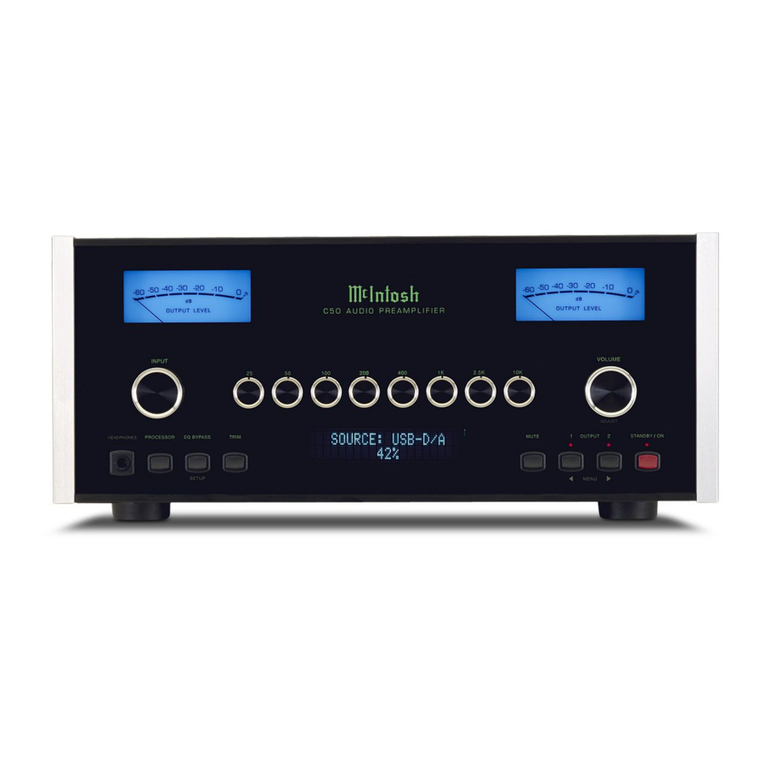
McIntosh
McIntosh C50 Control Connection Diagram
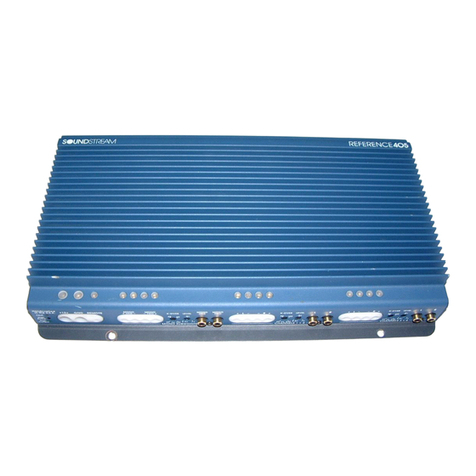
Soundstream
Soundstream REFERENCE 405 Owner's manual and installation guide
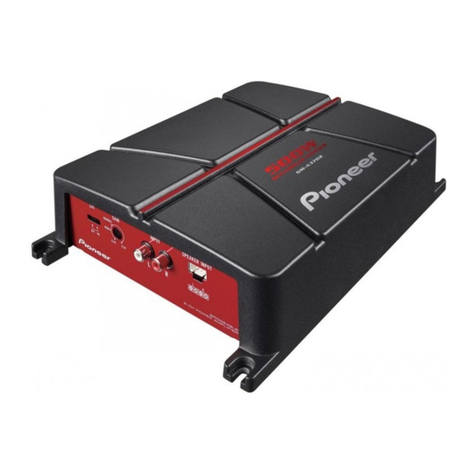
Pioneer
Pioneer GM-A5702 owner's manual

Extron electronics
Extron electronics DTP HD DA 4K Series user guide

X-Pulse
X-Pulse xp500.1 Installation & operating manual
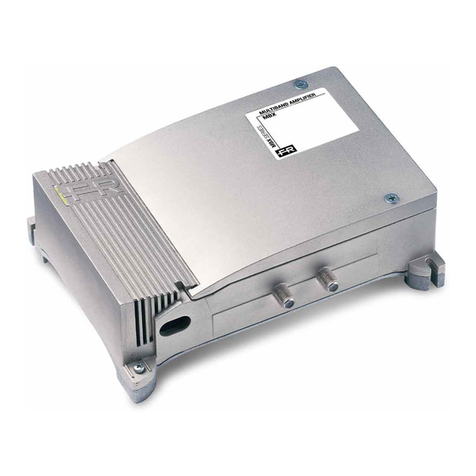
Fracarro
Fracarro MBX5851 operating instructions
